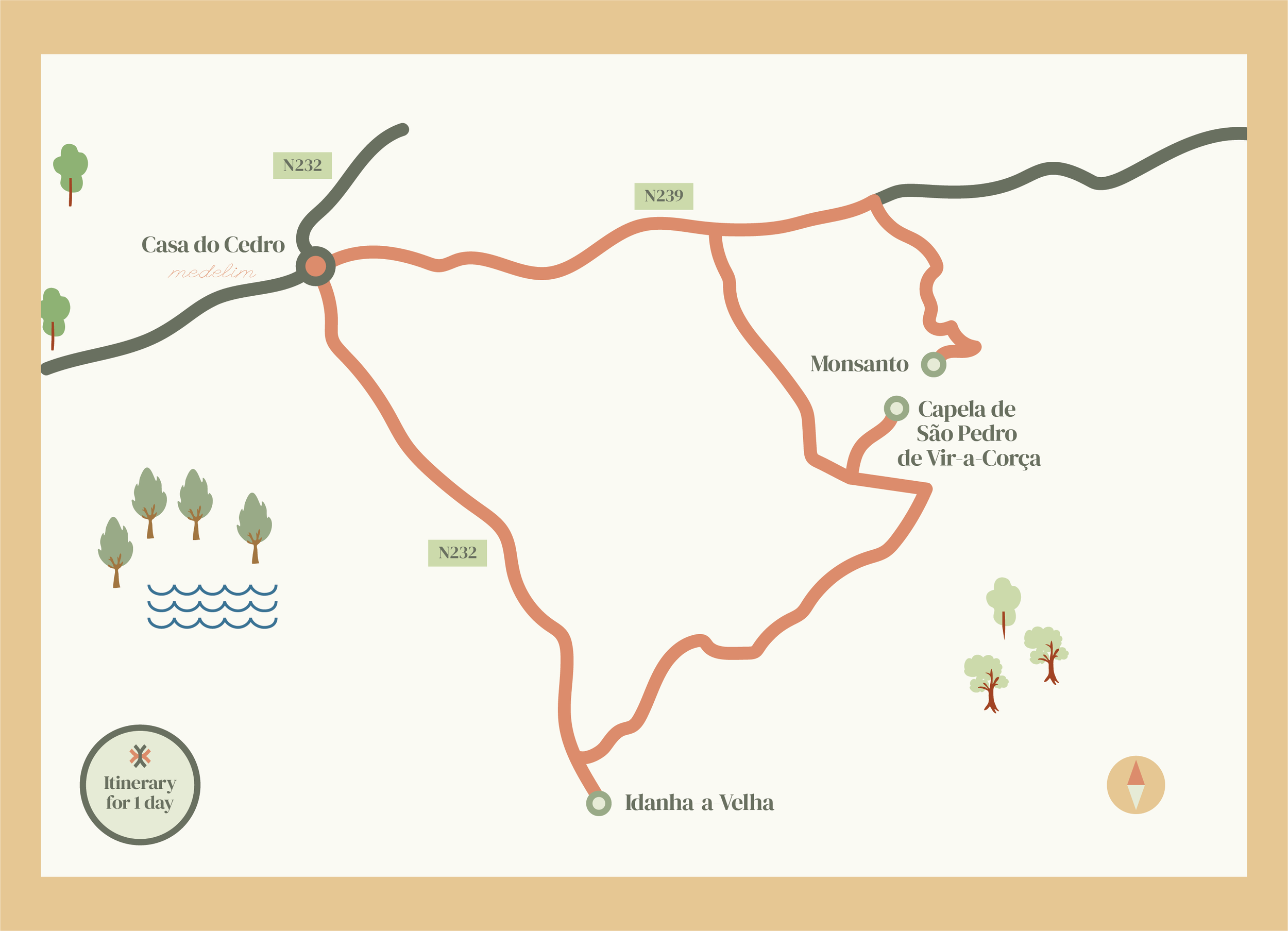Itinerary for 1 day
Itinerary
Medelim
Idanha-a-Velha
S. Pedro de Vir-a-Corça
Monsanto
Medelim
Explore the village ”Medelim de balconies, jews an Borrachões biscuits”, on a journey along the Balcony Route and discover stories and legends that carry the legacy of ancient civilizations dating back to prehistory, passing through the Romans, reign of King Sancho I among others important historical figures. It is also worth noting the Jewish heritage, strongly present in the built and intangible heritage.
Facts about Medelim:
Designation Medelim, derives from the name of a Roman army commander
In the Jewish quarter, the houses were connected through secret passages, with the objective of escape, at the time of the persecutions of the Jewish People.
Celebration of the internationally recognized and visited Jewish-Christian Feast (Easter)
Sephardic concerts shown in churches in the village
Feast of the Our Lord of Calvary celebrated in the last week of August
Medelim (foto: JALC)
Idanha-a-Velha (foto: JALC)
Idanha-a-Velha (foto: JALC)
Idanha-a-Velha e Monsanto
We head now to Idanha-a-Velha, following a Templar route. Visit the archaeological excavations and Porta Sul next to the Cathedral or Santa Maria, the Epigraphic Archive (one of the largest in the world), Suevi and Visigothic Baptistries, the Romanesque Bridge that crosses the Ponsul River, the Chapel of S. Dâmaso and the Family House, Morocco built on an ancient Roman Forum. From medieval times, be sure to see the Keep or the Templars Tower and the Wall surrounding the town.
We suggest a stop for a divine lunch at the Restaurante da Velha Fonte, Casa da Amoreira, prepared by Chef Maria Caldeira de Sousa (reservation is recommended).
On the way to Monsanto, we recommend a stop at S. Pedro de Vir-a-Corça, located between the cliffs of Monsanto and the place of Carroqueiro. It features a cave and a chapel. A place of silence, contemplation and enormous Templar mystique, worthy of a fairy tale, having been initially a Romanesque temple and later a hermitage sanctuary. Where legend has it that magicians existed…
Following the Barrocais Route, we now head to Monsanto, widely known as the “most Portuguese village in Portugal”, a place of inspiration for Zeca Afonso and Fernando Namora, where the granite boulders and the entire history of our most remote ancestors are manifested. Towards the highest peak, where the castle is, transformed by the Templar order into the Templar Tower, and also its geomorphological viewpoint, we find several points of interest: the Porta da Muralha Romana, the Fonte do Ferreiro, the Archaeological Station S. Lourenço, Igreja Matriz, Old Winery, Cruzeiro S. Salvador, Igreja da Misericórdia, Torre de Lucano (clock tower), Church of Santa Maria do Castelo, Viewpoint of the Ruins of the Capela S. João, Capela de Sto. António, Former Chapel of Socorro, Pelourinho, Granitic Inselberg, Ruins of the Romanesque Chapel of S. Miguel, Torre do Pião Ruins, Grotto, Penedo de Pé Calvo, Furdas, Monsanto Castle.
Facts about Monsanto:
Ant plague in the reign of Ring Manuel I led to an intense migration of the population to Monsanto
Templar Feast of Divina Santa Cruz (May 3rd or the following Sunday) in memory of the survival of the Monsantines to the invading siege.
Medieval Fair
Marafonas: typical Monsanto rag doll associated with fertility and home protection
Monsanto Castle was donated to Dom Gualdim Paes (6th Master of the Templar Order of Idanha a Velha and Monsanto) by King Afonso Henriques
Capela de São Pedro de Vir-a-Corça (foto: JALC)
Monsanto (foto: JALC)
Monsanto (foto: JALC)







